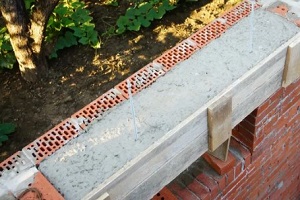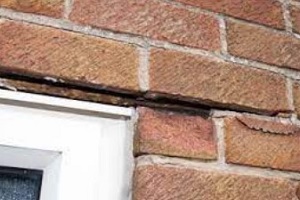 Both residential and commercial masonry buildings often benefit from the strength and longevity of the sustainable material. However, just because stone and brick are long-lasting materials does not mean that the entire structure is safe from decay. A building’s lintel is a particular area of concern, and no matter what type of building you own, you can be certain that your structure has at least one.
Both residential and commercial masonry buildings often benefit from the strength and longevity of the sustainable material. However, just because stone and brick are long-lasting materials does not mean that the entire structure is safe from decay. A building’s lintel is a particular area of concern, and no matter what type of building you own, you can be certain that your structure has at least one.
Here’s what you need to know about lintel deterioration, what causes it and how to fix it. The sooner repairs are made, the less damage your building will sustain and the lower the cost of repair will be.
What Is a Lintel?
No matter the building material, location, shape or use of a structure, every one of them will have at least one lintel. A lintel is a supporting structure in construction that sits on top of a gap, such as a window or door.
Lintels are necessary because the immense weight of the bricks and stones on top of these gaps can cause the window or door to collapse without the additional support. While most bricks sit on the ground and have support from beneath, the bottom bricks at the top of a window or door are suspended over nothing but air if a lintel is not used.
Sometimes it’s possible to see lintels, but other times, they are hidden so that the building looks seamless. When lintels are visible, they can contribute to the unique aesthetic of a structure, often appearing as an extra long and thick stone of a slightly different color above a window or door.
Why Does a Lintel Deteriorate?
 How a lintel breaks down over time will depend on the material that it’s made of. The most common type of lintels are made of steel thanks to its durability and low cost. Steel is not entirely water-resistant, so over time, a steel lintel can begin to rust or oxidize.
How a lintel breaks down over time will depend on the material that it’s made of. The most common type of lintels are made of steel thanks to its durability and low cost. Steel is not entirely water-resistant, so over time, a steel lintel can begin to rust or oxidize.
However, steel lintels are not typically exposed to the elements. The only way for water to get in is through cracks in the surrounding commercial masonry. This means that by keeping a building’s masonry in good repair, you can simultaneously prevent damage to nearby lintels.
Problems Caused by a Faulty Lintel
Understanding that lintels support the masonry above gaps like doors, windows and fireplaces should provide a preview of what could happen when a lintel fails. Once a lintel is no longer strong enough to support the immense weight of bricks or stones above it, those materials can begin to sag downward.
Without repair, they will collapse into the gap, caving in a door or window and threatening the structural stability of the building. Failing lintels pose a significant safety concern.
They also affect the visual appeal of a building, because some of the first signs of lintel deterioration are cracks and bulging around the corners of the window or door. This can make the building look uneven, and mortar that’s flaking away in the process gives the impression that the structure has not been cared for.
Can You Fix Lintel Deterioration?
Lintel deterioration is a serious concern, but it is fixable. The best strategy to avoid extensive lintel repairs is to prevent them in the first place. Lintels become damaged when the brick around them is compromised, so investing in consistent tuckpointing and commercial masonry maintenance will protect lintels. Have cracks in your commercial masonry repaired as soon as you notice them, and keep the mortar full and clean.
 If a lintel is already damaged from oxidation and rust, the next best step is to have it replaced. This should happen at the same time as surrounding mortar repair for the reasons mentioned above—if you replace a lintel without fixing the masonry, the new lintel won’t last long. A galvanized steel lintel can be installed in place of the previous device, but the masonry around the repair needs to be properly supported during the process.
If a lintel is already damaged from oxidation and rust, the next best step is to have it replaced. This should happen at the same time as surrounding mortar repair for the reasons mentioned above—if you replace a lintel without fixing the masonry, the new lintel won’t last long. A galvanized steel lintel can be installed in place of the previous device, but the masonry around the repair needs to be properly supported during the process.
This is why lintel replacement is not a safe DIY job, and it is a task best left to the professionals. They understand how to safely distribute the weight of the building off of the lintel while it is being repaired.
Get Lintel Repairs from a Trusted Expert
If you have reason to believe that your lintel is not working like it should be, the next best step is to reach out to experts who can repair it as soon as possible. Whether that means fixes to the localized masonry or a complete lintel replacement, the professionals at Waterproof Caulking & Restoration have you covered. We can pinpoint the cause of the issue and stop it from happening again. Get in touch to discuss your concerns or to schedule an appointment to get started.
